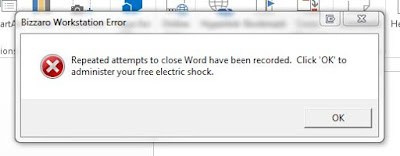For long time readers, you know that from time to time I have some guest articles pop up. Friend of the feed, Aaron Stone (proprietor of
Fearless Portraits), was asked to lay down some of his thoughts on a subject we had talked about in passing. With a little... encouragement, he got it finished for your perusal.
------------------------------------------------------------------------
I’m chained to a desk made of razorblades, surrounded by
barbed wire, armed thugs, and angry attack dogs, staring at a Word document
that says, “hey, write something from yer brain-meats for my blog.” If I’m never heard from again, these words
must serve as my mark upon the world.
We’ve all heard the saying, “if
you’re just performing for yourself, you’re masturbating.” When practicing, we performers tend to use
all kinds of methods to watch ourselves: odd angles, mirrors, cameras – the
idea that we can witness and review our own talent is intoxicating. However,
there’s a serious problem when you perform with your practicing habits: You look like you’re practicing.
Having trouble thinking of
examples? Ask yourself when you see
something, "would a professional do this?" The first one that comes to my mind is
watching someone performing card manipulations. A consummate professional will have a powerful stance, good posture, an
expression that fits the scene and character/persona, and clear actions. How often do you see someone back palm a
card, and they’re turned to watch it, too? You practice where you can see the moves you’re making – but if you’re a
professional, why are you watching your own hands?

Let’s take this thought a little
further before we hit the bigger one. Think of how you spring cards. When you are starting out learning to spring cards, regardless of the
exact method you use (I spring off the thumb, as you’ll see), you are more
focused on catching the cards than making it look pretty. This inherently means you’ll “follow through”
the spring, by ‘catching’ them with your throwing hand. Watch the GIF to understand, if that isn’t
clear.

The difference between practicing
and professional, is realizing what is “practice” and what is for
performance. The next GIF shows you what
the same spring flourish looks like with no follow-through, or ‘catch’ at the
end.

This minor change in presentation
greatly effects the perceived quality of your skills and performance. This is also just an easy example, but I
believe you should apply this thinking to all of your methods and
handlings.
To analyze your own material,
simply ask yourself, “WHY do I do it this way, and how would an ‘ideal’
magician do it if magic were real?”
Then, work to polish to perfection.
On my next point: Flow. Darwin Ortiz had a great section in his book,
“Strong Magic,” about timing in presentation.
I completely agree with all of it, and think you should read it (and
re-read it), but I want to expand upon that line of thinking with the addition of
Flow.
Your magic, your act, your
performance (whatever it may be) should have a smoothness to it. You NEVER want to tell a story in a framework
format. That’s a fancy English term for
“boring.” Example: if you can tell a
story by saying, “This happened, and then this happened, and then this
happened, but then THIS happened!” you’re not telling a story. You’re relaying facts.
“What should happen between every beat
that you’ve written down is either the word ‘therefore,’ or ‘but.’” – Trey
Parker, creator of South Park.
What that means, is that each beat
of a story can be a thought, or a moment. Real world example? Watch any
truly-professional show. The story, both
in movement and dialogue, will tell a story. However, if you’re doing “for my next trick,” if not done tongue-in-cheek,
feels cheap to an audience. You should
reach the peak of a thought, and the moment it loses interest: switch.
Switch? To what?
Another story! This is called
the, “Meanwhile, back at the ranch,” technique. You see this used frequently in movies, television shows, and even the
better live shows. You’ll see something
that has to do with the main story, then a “switch” to something unrelated,”
then back to the meat of the story.
Lather, rinse, repeat, until the final part of a great story.
And now, the beauty of it all: the
finale. A professional knows that their
performance is more than a series of tricks. More than just words. More than
patter and rehearsed motions. A professional act will take the audience through
a series of events, smaller stories, that all tie together into a cohesive
piece that will be memorable to your audience. Take the moments you’ve created thus far, and bring them together and hopefully receive abundant applause.
Look at what the people see. Sit for a moment and watch yourself perform,
from the perspective of a layperson. Are
you a professional, or are you still just practicing?






